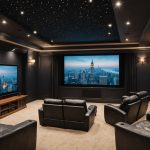Optimizing Lighting for Ambiance
When transforming a basement into a home theater, theater lighting plays a crucial role in setting the right ambiance enhancement. The first step is understanding the types of lighting suitable for home theaters. Ambient lighting, which provides general illumination, is a key component. It can be achieved with recessed lights or dimmable wall fittings.
For a cinematic experience, LED strip lights are invaluable. They can be installed along the floor skirting or ceiling edges, subtly illuminating the room without overpowering the screen. Wall-mounted sconces are also effective in offering soft, non-intrusive light that complements the theater vibe.
Also read : Ultimate guide for uk homeowners: designing your landscape to withstand floods
Natural light control is another important factor. Heavy drapes or blackout blinds help manage reflections and prevent unwanted light seepage during daytime movie marathons. Additionally, employing smart home technology to automate lighting adjustments can elevate the ambiance, seamlessly shifting from everyday brightness to movie-night dimness.
The combination of these lighting solutions ensures that basement lighting solutions create a perfect atmosphere, enhancing both the visual and experiential aspects of a home theater. Implementing these insights can help you achieve dramatic light effects while ensuring functional visibility.
Also to discover : Affordable composting ideas for your cozy uk townhome garden: embrace sustainable living!
Transforming Low Ceilings into Captivating Spaces
Crafting a home theater in a basement with a low ceiling requires strategic planning to optimize the space available. Start by considering the layout, as this will determine how well you can utilize every inch of the room. A well-thought-out plan ensures that the limited vertical space doesn’t hinder the basement transformation process.
When it comes to design, choosing the right color palettes can make a significant difference in how the ceiling height is perceived. Lighter shades often give the illusion of more height, creating an airy feel. Complement this with sleek wall treatments that draw the eyes upward, subtly enhancing the vertical dimensions of the space.
Take inspiration from successful projects that have transformed low ceilings into captivating areas. Often, a combination of clever home theater setup with strategically placed décor elements creates an immersive experience without sacrificing comfort. By understanding and implementing these techniques, you can achieve a stunning theater atmosphere despite ceiling constraints.
Selecting the Right Equipment
Creating a home theater setup in a basement involves choosing the right audio-visual equipment to suit the space’s unique constraints. When dealing with low ceilings, speaker placement is crucial. For optimal sound distribution, consider using wall-mounted or ceiling speakers, which save floor space while enhancing audio clarity.
Selecting a compatible projector is another key aspect, especially in tighter areas. Opt for a short-throw projector that allows for larger image projection from a shorter distance, making it ideal for low-ceiling environments. This ensures a clear, immersive viewing experience without requiring excessive space.
For seamless connectivity and integration, invest in essential accessories like high-speed HDMI cables and wireless streaming devices. These facilitate smooth audio and video transmission, enhancing the overall functionality and enjoyment of your setup.
Together, these elements create a harmonious blend of functionality and entertainment, enabling you to design a captivating home theater that meets both spatial and experiential needs. By strategically selecting equipment that fits your space, you will ensure a high-quality cinematic experience tailored to a basement setting.
Space-Saving Furniture Arrangement
Arranging furniture layout strategically in a basement transformation maximises the available space, ensuring comfort without clutter. Key to achieving this is selecting space-saving tips that accommodate the home theater setup seamlessly. Opt for furniture that enhances usability, such as sectional sofas or modular seating that can be reconfigured based on the occasion. This flexibility allows for optimal viewing arrangements without overcrowding.
For home theater seating, prioritising pieces that combine comfort with practicality is crucial. Recliners with built-in storage or cup holders offer added convenience while streamlining the space. Additionally, choosing slim, low-profile furniture helps maintain a sense of openness, particularly necessary for areas with a low ceiling design.
Incorporating multi-functional furniture solutions further enhances usability. Consider ottomans with storage capacities or foldable tables that serve dual purposes. This approach not only saves valuable floor space but also keeps the theater area organised. By employing these techniques, you can create a harmonious balance between aesthetic appeal and practical functionality, crafting an inviting atmosphere that complements your basement transformation vision.
Enhancing Acoustics and Soundproofing
Creating an immersive home theater acoustics experience in a basement involves strategic soundproofing methods and enhancing sound quality. One of the first steps is understanding the materials best suited for soundproofing. Dense materials like acoustic panels, foam tiles, and even heavy drapes can effectively absorb and dampen sound, reducing echo and preventing noise seepage.
To optimise acoustic treatments, it’s essential to focus on panel placement. Positioning panels on walls, particularly at reflection points where sound bounces off the walls, helps in achieving clearer sound. Consider also installing carpets or rugs, which can significantly reduce sound reflections from floors.
For a more budget-friendly approach, do-it-yourself (DIY) soundproofing techniques can be highly effective. Simple solutions such as using egg cartons, thick curtains, or bookcases filled with books can absorb sound, offering a reasonable degree of soundproofing without excessive expenditures.
By carefully selecting and employing effective soundproofing methods, you can dramatically improve your basement theater’s sound quality, ensuring a truly immersive audio experience that enhances the overall enjoyment and realism of your home theater setup.
Budget-Friendly Options and DIY Solutions
Building an affordable home theater in your basement doesn’t mean you have to sacrifice quality. There are plenty of creative ways to source materials and equipment without overspending. Explore local classifieds and online marketplaces for second-hand projectors, speakers, and other audio-visual equipment. These platforms often offer great deals that can help lay the foundation for your setup.
Engage in DIY projects to further enhance your theater experience. For instance, constructing your own projector screen using fabrics and wooden frames can be significantly cost-effective. Similarly, acoustic panels can be crafted at home using simple household items like foam and fabric, enabling effective soundproofing without a hefty price tag.
Implementing cost-saving strategies doesn’t mean you have to compromise on ambiance or functionality. Consider repurposing existing furniture to fit your theater setup. Use dimmable LED bulbs to create adjustable lighting that suits any occasion. By focusing on smart spending and ingenious solutions, you can balance quality and affordability, achieving a cinematic feel that transforms your basement into a captivating home theater.











